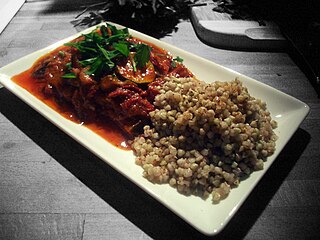
Turkish cuisine is the cuisine of Turkey and the Turkish diaspora. Although the cuisine took its current rich form after numerous cultural interactions throughout centuries, it should not be confused with other cuisines such as Ottoman cuisine or Seljuk cuisine. Turkish cuisine with traditional Turkic elements such as yogurt, ayran, kaymak, exerts and gains influences to and from Mediterranean, Balkan, Middle Eastern, Central Asian and Eastern European cuisines.

Meze is a selection of small dishes served as appetizers in Armenian, Balkan, Greek, Levantine, and Turkish cuisines. It is similar to Spanish tapas and Italian antipasti. A meze may be served as a part of a multi-course meal or form a meal in itself. Meze are often served with spirits such as arak, rakia, raki, oghi, ouzo, or grappa at meyhane and ouzeri or at regular restaurants.

Moussaka is an eggplant (aubergine)- or potato-based dish, often including ground meat, which is common in the Balkans and the Middle East, with many local and regional variations.

Bulgarian cuisine is part of the cuisine of Southeast Europe, sharing characteristics with other Balkan cuisines. Bulgarian cooking traditions are diverse because of geographical factors such as climatic conditions suitable for a variety of vegetables, herbs, and fruit. Aside from the variety of local Bulgarian dishes, Bulgarian cuisine shares a number of dishes with its neighboring countries, in particular with Turkish and Greek cuisine.

Arab cuisine collectively refers to the regional culinary traditions of the Arab world, consisting of the Maghreb and the Mashriq. These cuisines are centuries old and reflect the culture of trading in ingredients, spices, herbs, and commodities among the Arabs. The regions have many similarities, but also unique traditions. They have also been influenced by climate, cultivation, and mutual commerce.

Iraqi cuisine is a Middle Eastern cuisine that has its origins in the ancient Near East culture of the fertile crescent. Tablets found in ancient ruins in Iraq show recipes prepared in the temples during religious festivals—the first cookbooks in the world. Ancient Iraq's cultural sophistication extended to the culinary arts.

Parmigiana, also called parmigiana di melanzane, melanzane alla parmigiana or, in the United States, eggplant parmesan, is an Italian dish made with fried, sliced eggplant layered with cheese and tomato sauce, then baked. The origin of the dish is claimed by the southern regions of Calabria, Campania, Apulia and Sicily.

Levantine cuisine is the traditional cuisine of the Levant, in the sense of the rough area of former Ottoman Syria. The cuisine has similarities with Egyptian cuisine, North African cuisine and Ottoman cuisine. It is particularly known for its meze spreads of hot and cold dishes, most notably among them ful medames, hummus, tabbouleh and baba ghanoush, accompanied by bread.

Balearic cuisine is a Mediterranean cuisine as cooked in the Balearic Islands, Spain. It can be regarded as part of a wider Catalan cuisine, since it shares many dishes and ingredients with Catalonia and the Valencian Community. Others view it as part of a more global Spanish cuisine. Traditional Balearic cuisine is rich in vegetables, cereal and legumes as well as being low in fats. A succinct selection of the primary dishes would be ensaimades, seafood and vegetable stews, sobrassada, coques, tombet, Maó cheese and wine.

Tunisian cuisine, the cuisine of Tunisia, consists of the cooking traditions, ingredients, recipes and techniques developed in Tunisia since antiquity. It is mainly a blend of Mediterranean and native Berber cuisine with Punic influences. Historically, Tunisian cuisine witnessed influence and exchanges with many cultures and nations like Italians, Andalusians, French and Arabs.

Ratatouille is a French Provençal dish of stewed vegetables that originated in Nice and is sometimes referred to as ratatouille niçoise. Recipes and cooking times differ widely, but common ingredients include tomato, garlic, onion, courgette (zucchini), aubergine, capsicum, and some combination of leafy green herbs common to the region, such as chives or fennel.

Many cuisines feature eggplant salads and appetizers.

Venetian cuisine, from the city of Venice, Italy, or more widely from the region of Veneto, has a centuries-long history and differs significantly from other cuisines of northern Italy, and of neighbouring Austria and of Slavic countries, despite sharing some commonalities.

Cappon magro is an elaborate Genoese salad of seafood and vegetables over hardtack arranged into a decorative pyramid and dressed with a rich sauce.















